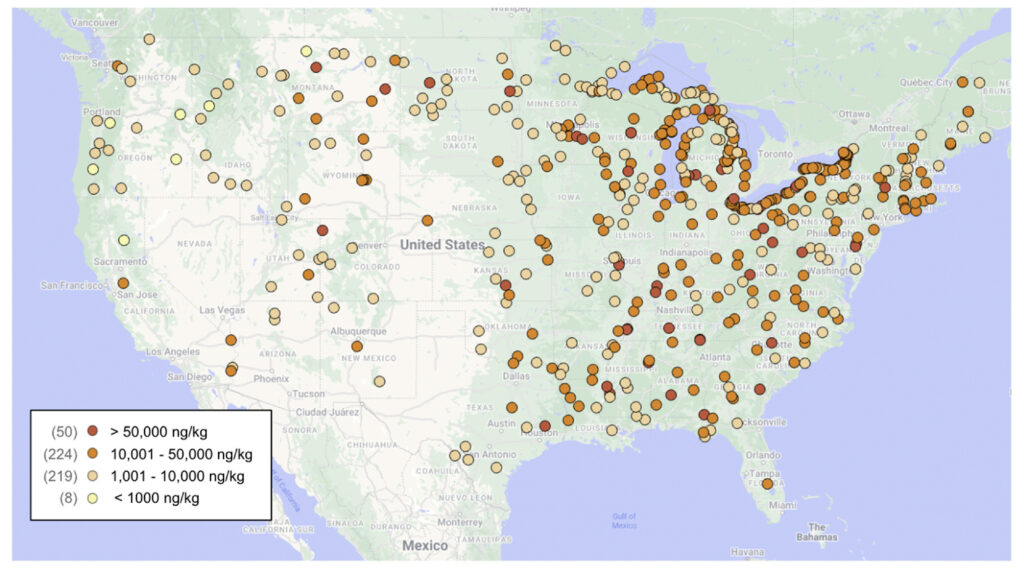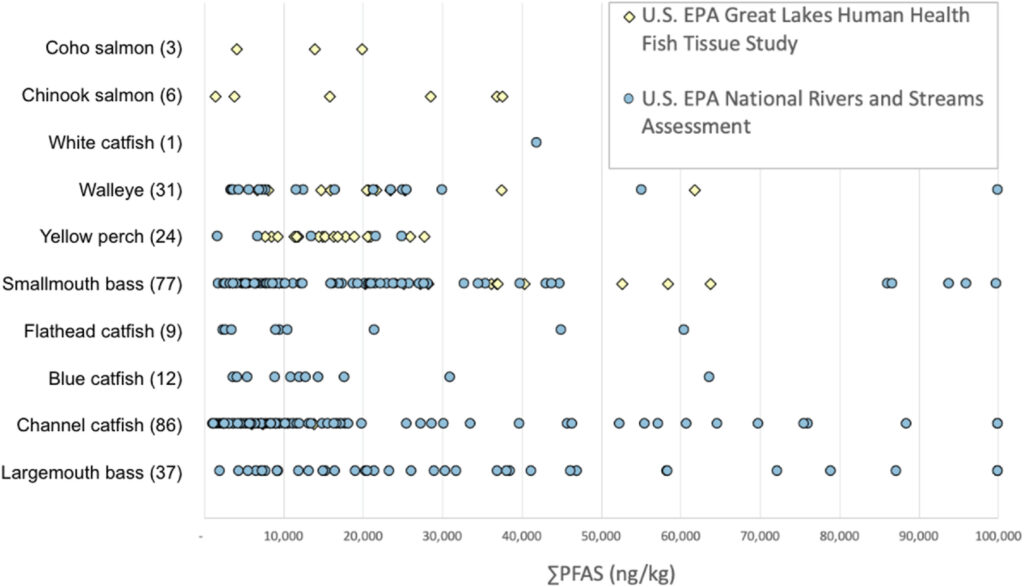Monday May 8, 2023

There are many things that people wish could last forever, like the smell of spring, fresh produce, or wildflowers. One thing that would likely never make this list is harmful chemicals, but in some cases, they have the potential to persist for a very long time. Researchers recently identified alarming amounts of these “forever” chemical pollutants in freshwater fish residing in streams and rivers within the United States. Specifically, the study found large quantities of a common manufacturing chemical, often referred to under the umbrella term PFAS or polyfluoroalkyl, within the tissues of fish. PFAS have both water- and oil-repelling bonds, meaning any water or oil that comes in contact with the chemical, gets repelled. This characteristic makes PFAS a perfect component in packaging materials, fire-fighting foams, stain or water-resistant clothing, and many other necessities. However, because PFAS don’t dissolve, they are incapable of naturally degrading in the environment, or in a living body. PFAS are used at manufacturing facilities all over the US, and traces of these toxic chemicals are leaching into and can be found in nearly all environments, including many rivers and streams. To better understand the effects this will have on the human population, a group of researchers at Duke University used statistical modeling to quantify the level of PFAS contamination in humans based on freshwater fish consumption in the US (Barbo et al. 2023).

The study used data generated by the Environmental Protection Agency (EPA) on the number and location of freshwater fish caught in the United States. The researchers also used data from the Food and Drug Administration (FDA) on commercially caught fish, and the National Health and Nutrition Examination Survey on PFAS concentrations in the general human population. Researchers used these datasets to create comprehensive models that could predict the total PFAS concentrations in humans resulting from the consumption of locally sourced freshwater fish.
After applying the model, the researchers found that all 48 states considered in the study contained at least one individual freshwater fish with PFAS contamination. In addition, when comparing urban to non-urban areas affected by PFAS, the study found that urban areas had 1.5 to 1.6 times more PFAS on average. The most commonly sampled fish species in this study that are frequently caught and consumed in the US included largemouth and smallmouth bass (Micropterus salmoides and M. dolomieu), many species of catfish, and Chinook and Coho salmon (Oncorhynchus tsawytscha and O. kisutch). The three sampled species in this study with the highest PFAs concentrations were the channel catfish (Ictalurus punctatus) with a range of 5,447-17,628 ng/kg, smallmouth bass with a range of 7,763-28,227 ng/kg, and largemouth bass with a range of 9,397-41,219ng/kg. The study found that overall many of the 48 states had fish with PFAS ranging from 1,000-50,000 ng/kg. For perspective, just eight ounces of fish containing 1,000 ng/kg of PFAS, which is considered a low concentration, would be equivalent to consuming 290 times the EPA health advisory level for one whole month. Alarmingly, the study also suggested that eating only eight ounces of fish contaminated with 41,400 ng/kg of PFAS, a higher concentration, would be equivalent to consuming 11,854 times the EPA health advisory for one month. Even more concerning, the highest level of PFAS in a freshwater fish sample from the EPA database was 286,767 ng/kg.

While many states have existing advisories warning against consuming certain freshwater fish caught in contaminated waters, there are only 14 states that offer specific PFAS considerations. Also, there are no existing federal regulations aimed at controlling PFAS in freshwater in the United States. This is a serious issue because many indigenous Tribal Nations in the U.S. traditionally catch local freshwater fish as part of their cultural identity and this lack of regulation may put them at greater risk. According to this study, consuming large quantities of PFAS can lead to numerous health risks such as cancer, a weak immune system, high cholesterol, thyroid disease, and reproductive or developmental problems. The researchers concluded their study by urging the government to develop and establish new regulations that address the PFAS issue head-on, with the goal of tracking and reducing the PFAS levels in freshwater across the country. With proper regulations in place, toxic levels of PFAS in local freshwater fish could be reduced, resulting in healthier food sources for consumers who rely on this food source.
Emily Donahue contributed this story as part of an internship with FISHBIO.
This post was featured in our weekly e-newsletter, the Fish Report. You can subscribe to the Fish Report here.
